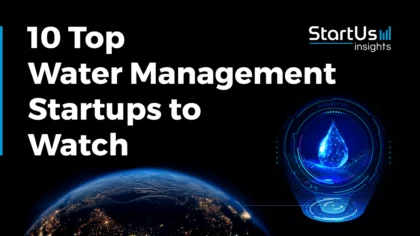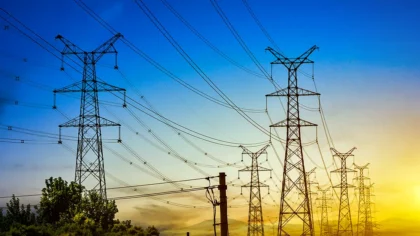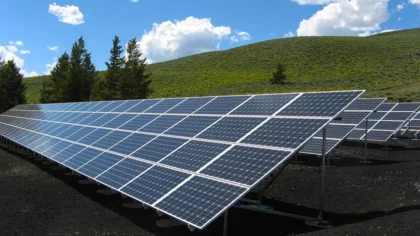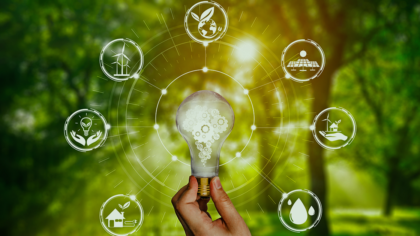Accelerate Productivity in 2025
Reignite Growth Despite the Global Slowdown
The utility industry forms the base of urban population and management. AI is an emerging technology that assists the utility industry in staying ahead by improving demand forecasting, resource allocation, and infrastructure design and deployment. For example, AI is enabling energy companies to optimize resources and better manage the grid. By using machine learning algorithms, the utility industry predicts energy consumption patterns with unprecedented accuracy, which enables more efficient resource management and reducing waste.
AI-powered systems also optimizes fraud detection and reduces instances of resource and power theft. By optimizing resource allocation, AI ensures prompt workforce scheduling in response to customers’ issues and improves customer experience in the long run. Furthermore, AI plays a crucial role in designing and deploying smart grid systems, water distribution layouts, telecom infrastructures along with facilitating the integration of renewable energy sources.
Why should you read this report?
- Gain in-depth insights into the top 10 use cases of AI in utility.
- Learn about three practical use cases for each use case.
- Meet 10 innovative startups advancing these applications.

Key Takeaways
- Renewable Energy Integration
- Use Cases:
- Load Balancing
- Advanced Control System
- Virtual Power Plants
- Startup to Watch: Resilient Entanglement
- Use Cases:
- Customer Management
- Use Cases:
- Personalized Billing
- Self-Service Platforms
- Demand Side Management
- Startup to Watch: POWERCONNECT.AI
- Use Cases:
- Asset Management
- Use Cases:
- Infrastructure Monitoring
- Investment Planning
- Risk Management
- Startup to Watch: Senpilot
- Use Cases:
- Demand Forecasting
- Use Cases:
- Dynamic Pricing Optimization
- Error Reduction in Forecasting
- Demand Hours Analysis
- Startup to Watch: Endre
- Use Cases:
- Energy Storage Optimization
- Use Cases:
- Hybrid Energy Systems
- Backup Management
- Energy Trading
- Startup to Watch: Allye Energy
- Use Cases:
- Anomaly and Fraud Detection
- Use Cases:
- Real-Time Asset Monitoring
- Meter Tampering Detection
- Behavioral Analytics
- Startup to Watch: Byanat
- Use Cases:
- Resource Allocation
- Use Cases:
- Emergency Responses
- Spare Parts and Inventory Optimization
- Demand Response Management
- Startup to Watch: Dryp
- Use Cases:
- Emission Reduction
- Use Cases:
- Real-Time Emission Tracking
- Incentive Programs
- Sustainability Compliance
- Startup to Watch: Emissium
- Use Cases:
- Disaster Management
- Use Cases:
- Early Warning Systems
- Rapid Response and Recovery
- Disaster Impact Analysis
- Startup to Watch: Spacegen
- Use Cases:
- Infrastructure Designing and Deployment
- Use Cases:
- Predictive Maintenance
- Geospatial Analysis
- Site Selection
- Startup to Watch: Aquanuity
- Use Cases:
How We Identify Emerging Technologies & Startups
The data in this report originates from StartUs Insights’ Discovery Platform, covering 4.7+ million global startups, scaleups, and technology companies, alongside 20K emerging technology trends. Our platform makes startup and technology scouting, trend intelligence, and patent searches more efficient by providing deep insights into the technological ecosystem. Utilizing the trend intelligence feature, we analyze industry-specific technologies for this report, detect patterns and trends, and identify use cases along with the startups advancing these areas. Further details and capabilities are accessible via the website.
Top 10 Applications of AI in Utilities Sector [2025 & Beyond]
1. Renewable Energy Integration
Renewable energy sources like wind and solar are dependent on weather conditions, which makes the energy output uncertain. AI uses machine learning models to analyze weather data, historic energy production, and current environmental conditions to accurately forecast energy generation.
This assists grid operators in load balancing and optimizing control systems. AI analyzes historical and real-time data grid reliability to streamline energy distribution and shorten power outage durations. Additionally, smart grids equipped with AI autonomously manage energy flows by optimizing the distribution of renewable energy. This ensures that the grid operates efficiently despite the integration of various energy resources.
Dive Deeper:
- Noteworthy Example: E.ON integrates AI to enhance efficiency in renewable energy operations, utilizing predictive maintenance and optimizing grid performance to support the energy transition. Their AI tools help in equipment monitoring and maintenance prediction, substantially reducing grid failures.
- Financial Landscape: The average funding for startups using AI to integrate renewable energy in the utilities industry is USD 23.5 million.
Startup to Watch: Resilient Entanglement
US-based startup Resilient Entanglement offers a climate-resilient energy management system (EMS). It is a quantum-AI-powered software platform that assists utility companies in improving energy efficiency. The platform offers operators a comprehensive view of their utility network and allows them to monitor real-time data to minimize waste, detect maintenance issues early, and recommend cost-saving measures. Resilient Entanglement’s innovative software easily integrates into residential, commercial, and industrial (RCI) electricity systems for use by electric utilities and system operators. This allows companies to reduce operational costs and greenhouse gas emissions.
2. Customer Management
AI-powered chatbots and virtual assistants use natural language processing (NLP) to ensure personalized and accurate responses based on customer preferences and historical interactions. These tools answer frequently asked questions, resolve billing issues, and assist with account management. It also enables self-servicing platforms and generates personalized billing to reduce dependency on the human workforce.
Additionally, AI empowers predictive analysis, where data from smart meters and IoT devices are used to predict potential issues and schedule maintenance. This method manages demand side management by alerting customers about potential outages, maintenance schedules, and changes in energy prices within time. It also alerts customers about high or unusual consumption patterns before it generates a high bill.
Dive Deeper:
- Noteworthy Example: Salesforce offers AI-powered tools for utilities through their Energy and Utilities Cloud. These tools can recommend next best actions, provide knowledge articles to support agents and customers and deploy chatbots for better online self-service options. Their AI capabilities can analyze large amounts of data, including historical usage, weather patterns, and call data to detect unusual consumption spikes and send proactive, personalized notifications to customers
- Financial Landscape: The average funding for startups using AI to manage customers in the utility industry is USD 9.1 millioon.
Startup to Watch: POWERCONNECT.AI
US-based startup POWERCONNECT.AI provides a platform that improves customer-agent interactions in the utility industry. The AI-powered platform offers chatbot and voice technology for customer-agent interactions in the utility industry. It improves efficiency and reduces operational costs. The platform also features solutions like the AI self-serve advisor that offers seamless support and analytics to track and analyze performance to better understand user behavior and refine service strategies. It also provides AI-powered search for accurate and context-aware results, and an AI agent assistant using natural language processing (NLP) for performing tasks and supporting customers.
3. Asset Management
AI optimizes the performance of assets by analyzing operational data to identify inefficiencies or suboptimal usage. Such solutions recommend adjustments to the operation and investment planning of equipment such as turbines, generators, or energy storage systems to maximize output and efficiency. AI also automates telecom and power infrastructure monitoring by determining the most suitable time for service without disrupting operations. Additionally, AI allows remote monitoring of assets across wide geographical areas to optimize risk management and increase asset lifespan.
Dive Deeper:
- Noteworthy Example: PG&E has implemented machine learning to strengthen its power grid. They use AI and predictive analytics to anticipate peak demand periods and proactively allocate resources, improving grid stability and reducing costs.
- Financial Landscape: The average funding for startups using AI for asset management in the utility industry is USD 24.3 million.
Startup to Watch: Senpilot
Canadian startup Senpilot provides Copilot, a platform for utility asset management. It uses a vast database of regulatory filings to generate draft reports and provide valuable insights. The platform incorporates specific asset field data, creates charts, and aids in decision-making by analyzing changes in scoring formulas and referencing past reports for continuity.
Copilot finds applications in various utility functions, including outage management, where it uses AI to analyze data in the early minutes of an outage to speed up disaster recovery. It also strengthens assets by using advanced topographic forecasting and protecting against severe weather. It also manages bidirectional energy flows with AI for DER/DERMS and handles tasks like monitoring, bidding, forecasting, optimization, and quality control in real time.
4. Demand Forecasting
Since weather conditions influence utility use, AI algorithms analyze real-time weather data to anticipate drops or spikes in demand and generation. For this, businesses analyze temperature, humidity, wind patterns, and solar radiation. AI solutions further examine non-linear relationships like the interaction of energy consumption with social behavior, industrial activity, and climate patterns. As rainwater harvesting and rooftop solar panels become more integrated in the utility sector, AI contributes to forecasting the dynamic changes in prices due to this combination.
Dive Deeper:
- Noteworthy Example: NREL uses AI to predict solar and wind energy generation accurately. These predictions help grid operators make real-time decisions on energy distribution, maximizing the use of renewable sources and minimizing reliance on fossil fuels.
- Financial Landscape: The average funding for startups using AI for demand forecasting in the utility industry is USD 6.8 million.
Startup to Watch: Endre
Swedish startup Endre develops a platform using AI to generate insights into the electricity usage of customers and resources. The platform optimizes grid layouts, streamlines data processes, and supports collaboration among stakeholders. It enables accurate demand forecasting, improves grid resilience, and enhances energy planning and management. It also provides flexibility assessment, digital customer twin, long-term planning forecasts, public charging assessment, renewable energy potential analysis, and more. The platform benefits operators, consultants, academics, municipalities, and cities.
5. Energy Storage Optimization
The unpredictable weather and population movement have led to shortages in several areas of the utility industry. For load balancing and peak shaving, AI algorithms analyze data to predict demand fluctuations, and optimal charging, and discharging of storage systems. The algorithms further predict potential failures in the grids and activate storage for emergency backup and blackout prevention.
Technologies like machine learning continuously learn from usage patterns and ensure dynamic pricing and demand response. It optimizes storage allocation by determining ideal sizes and locations within the grid. AI also advances innovations like hybrid energy systems and energy trading, which are major ways of managing shortages in the utility industry. AI monitors the performance and health of the storage facility to keep it running for the longest time. The contribution of AI to improve storage mechanisms also led to renewable energy integration by reducing dependency on fossil fuels.
Dive Deeper:
- Noteworthy Example: Evergen has developed an AI-powered platform for optimal use of solar and battery energy resources. Their system uses AI to monitor weather forecasts and calculate how much energy should be stored, then distributes stored electricity during periods of low solar production. The Evergen app leverages AI for power trading and distribution, peak demand avoidance, demand response services, and grid stabilization management.
- Financial Landscape: The average funding for startups using AI to optimize energy storage in the utility industry is USD 30.2 million.
Startup to Watch: Allye Energy
UK-based startup Allye Energy offers MAX, a flexible, modular, and easy-to-deploy mobile energy storage system. It predicts energy usage and optimizes charging and discharging while offering full transparency and remote support for an improved user experience. The system enables energy arbitrage, power boosts, renewable storage, and promotes sustainability, replacing diesel generators and battery energy storage systems (BESS). This reduces energy costs by storing low-cost power and delivering high power to address grid constraints. MAX operates on or off the grid and maximizes safety and longevity through intelligent monitoring. Moreover, it uses repurposed EV batteries to reduce emissions.
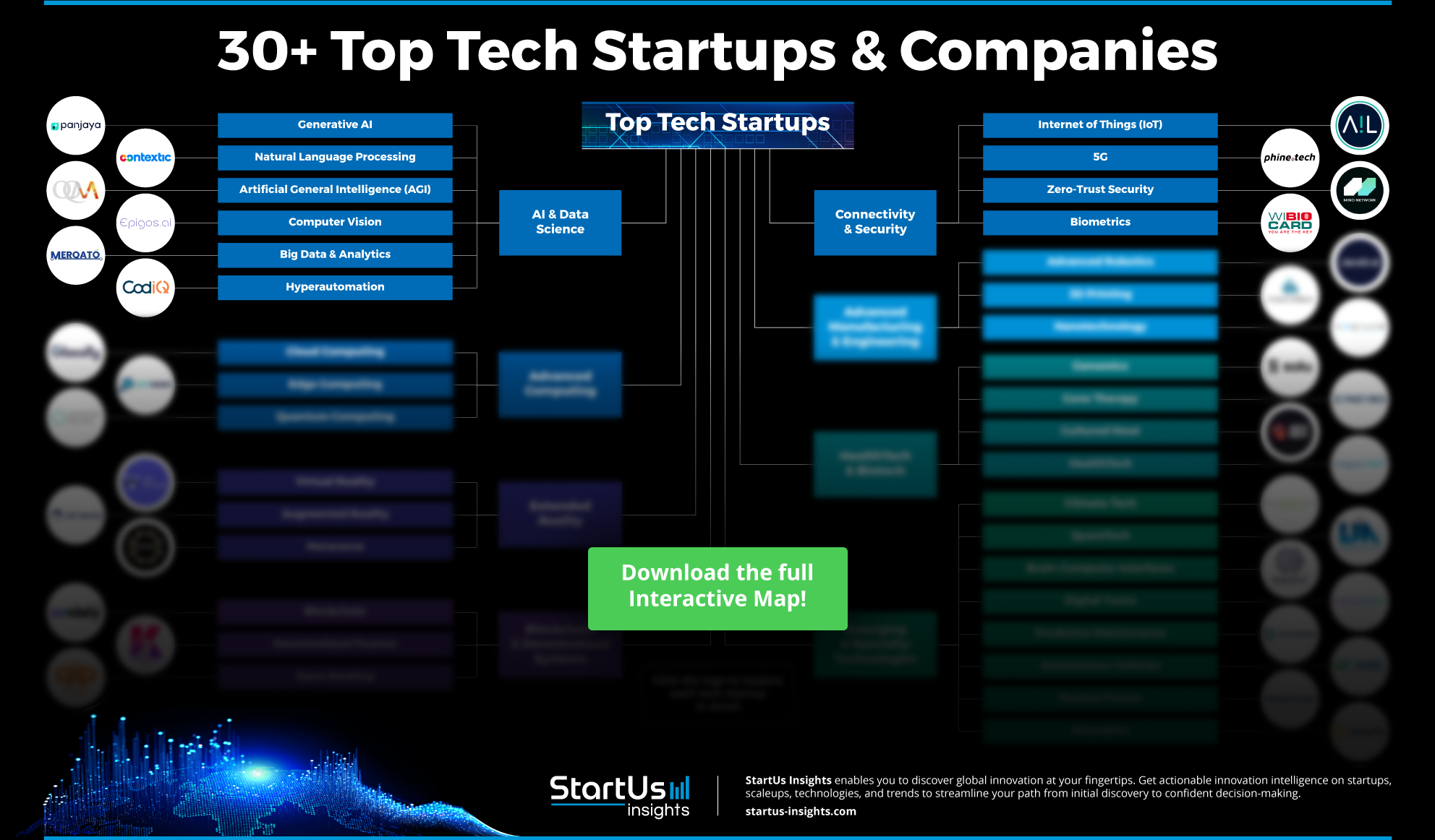
6. Anomaly and Fraud Detection
Through real-time asset monitoring, AI detects operational anomalies such as sudden increases in energy loss or water leakage. This allows utilities to take corrective actions quickly. Additionally, AI models use pattern recognition to compare real-time household or industrial usage with conventional consumption data. This allows companies to identify cases of energy stealing by illegal connections. It also uses time-series data to spot potential fraudulent behaviors like meter tampering, billing fraud, unauthorized asset accessing, and more. Machine learning further continuously monitors customer behavior to minimize downtime.
Dive Deeper:
- Noteworthy Example: Comarch‘s AI solutions are applied within the utility industry to enhance operational efficiency, including predictive maintenance and resource management. They specifically address issues like fraud detection, improving service delivery, and minimizing operational costs.
- Financial Landscape: The average funding for startups using AI for anomaly and fraud detection in the utility industry is USD 7.4 million.
Startup to Watch: Byanat
Saudi Arabian startup Byanat offers a platform that offers a comprehensive view of utility networks and improves operational efficiency. It uses self-automated AI to deploy precise actions while maintaining compliance, sustainability, and profitability. The platform optimizes smart grids and improves metering infrastructure. Additionally, Byanat’s platform provides personalized visualization options and configurable workflows for utility companies to streamline operations and make data-driven decisions. By combining these features, Byanat empowers utility providers to identify fraud and anomalies.
7. Resource Allocation
AI optimizes emergency responses by analyzing real-time data from weather forecasts and historical incidents to predict emergencies and identify high-risk areas. It automates crew dispatch and improves communication with customers through AI-driven platforms. For spare parts and inventory optimization, AI forecasts demand using historical data to reduce excess inventory and automate inventory management by monitoring stock levels. Additionally, AI contributes to grid optimization, predictive maintenance for asset management, and improved asset management through demand prediction and supply monitoring.
Dive Deeper:
- Noteworthy Example: IBM‘s Hybrid Renewable Energy Forecasting (HyREF) technology, adopted in China, uses cloud-imaging technology and sky cameras to predict solar power generation. This AI-powered solution helps in integrating renewable energy sources more efficiently into the grid.
- Financial Landscape: The average funding for startups using AI for resource allocation in the utility industry isUSD 6.4 million.
Startup to Watch: Dryp
Danish startup Dryp builds a water monitoring system. It combines sensors and an analytics platform, Lens. The sensors collect data on various water parameters like soil moisture, water quantities, precipitation, and more. This enables accurate monitoring for resource management and conservation in industrial applications. Lens then analyzes the collected data, as well as third party data like SCADA, GIS, flow measurements, rain gauges, and more. This analysis aids in urban water monitoring, operating, and planning. Lens further offers quick overview, detailed insights, metadata and notes, export functionality, and data annotation and validation.
8. Emission Reduction
Through real-time emission tracking, AI identifies specific sources and optimizes operations to reduce emissions during peak usage. This enables dynamic incentive structures based on consumer behavior and encourages energy-efficient practices. AI also streamlines sustainability compliance by automating data collection for emissions reporting and ensuring utilities meet regulatory requirements. Additionally, AI optimizes the integration of renewable energy sources, supports energy efficiency programs, and improves carbon capture technologies.
Dive Deeper:
- Noteworthy Example: C3 AI commits to achieving net-zero greenhouse gas emissions by 2050, with interim goals for 2030 and 2035, employing AI technologies to monitor and report on emissions and energy usage. Their initiatives include the C3 AI Energy Management and C3 AI ESG applications which streamline data gathering for sustainability goals and enhance energy efficiency through predictive analytics.
- Financial Landscape: The average funding for startups using AI to reduce emissions in the utility industry is USD 14.1 million.
Startup to Watch: Emissium
Swiss startup Emissium offers a machine learning-based platform designed to facilitate energy monitoring, carbon accounting, and the reduction of electricity emissions. Its electricity network API enables power producers to identify the sources of their electricity emissions, monitor their emissions, maintain transparency in results, and save time while ensuring accuracy, and ultimately reducing electricity emissions.
Emissium accounts for all scope 2 and 3 electricity emissions through a highly detailed time and space granular system and captures a broad spectrum of environmental data. It utilizes the latest methods and metrics to guarantee complete transparency and accuracy while processing data quickly and efficiently to meet the highest standards of precision.
9. Disaster Management
AI improves disaster management in the utility industry by improving preparedness, response, and recovery efforts. AI issues early warning by analyzing data from weather forecasts and historical patterns to predict potential disasters. To ensure rapid response and recovery, AI automates damage assessments using satellite imagery and sensor data, which allows for quick evaluation of infrastructure damage and optimized resource allocation for efficient recovery. Additionally, AI facilitates disaster impact analysis by analyzing geospatial data of the affected area.
Dive Deeper:
- Noteworthy Example: AiDash has developed the Climate Risk Intelligence System (CRIS), a satellite- and AI-powered SaaS offering that helps utility and energy companies manage the impact of natural disasters, including storms and wildfires. CRIS works in near real-time before, during, and after a major natural disaster or extreme weather events.
- Financial Landscape: The average funding for startups using AI for disaster management in the utility industry is USD 12.7 million.
Startup to Watch: Spacegen
Malaysian startup Spacegen builds a satellite remote sensing (SRS) technology that uses AI and satellite imaging. The technology facilitates real-time detection of mountain fire along power transmission routes using geosynchronous and low-orbit satellite data. It also provides fire site coordinates and assesses the risk to transmission lines.
Further, the company offers high-resolution SRS services for detecting potential intrusions in power transmission networks and monitoring ground activities such as construction sites, engineering vehicles, trenching, and stone accumulation. Spacegen also provides typhoon transit safety assessments for power transmission towers. It monitors and predicts typhoon trends and provides early warnings to areas at risk. This provides critical information to support disaster relief efforts.
10. Infrastructure Design and Deployment
To enable predictive maintenance, AI analyzes sensor data and historical records to forecast equipment failures. This allows utilities to schedule maintenance proactively, reduce downtime, and extend asset lifespan. Geospatial analysis further aids in understanding the geographical context of infrastructure, which assists utility providers in identifying optimal locations for new projects while assessing environmental impacts and accessibility.
In terms of site selection, AI integrates various data sources to evaluate potential locations based on risk assessments and cost-benefit analyses. This ensures compliance and minimizes risks. Additionally, AI optimizes design configurations through simulations, allocates resources effectively during deployment, and monitors construction progress in real-time.
Dive Deeper:
- Noteworthy Example: General Electric uses AI algorithms in its wind turbines for asset optimization. The AI continuously monitors turbine performance, adjusting parameters to optimize power generation. Their predictive maintenance models identify potential issues and schedule maintenance when necessary, increasing turbine reliability and energy output
- Financial Landscape: The average funding for startups using AI for designing and deploying infrastructure in the utility industry is USD 25.2 million.
Startup to Watch: Aquanuity
US-based startup Aquanuity offers an AI-powered, climate-smart platform for water infrastructure management. The company’s digital twin product, AquaTwin Asset, is a simulation-based tool for self-service water, wastewater, and stormwater condition assessments and risk-based capital planning. It aids in field investigations, assesses risk levels, and prioritizes repair and replacement activities.
AquaTwin Water, the company’s AI-powered geocentric digital twin software, provides infrastructure risk and resilience analysis along with scenario management. Its other product, AquaTwin Sewer, improves water infrastructure management by optimizing modeling capabilities, customer impacts, and geocentric processing. With its suite of products, Aquanuity transforms the way water infrastructure is constructed, operated, or maintained.
Don’t Miss Out on the Latest AI-driven Utilities Innovations
Investment in the utility industry is dynamic, with over 2,700 funding rounds closed, supported by 1,000+ investors, and funding for over 900 companies. Major players like Techstars, Y Combinator, Antler, Entrepreneur First, and EIT Urban Mobility drive this ecosystem. Funding types include Seed, Early Stage VC, Pre Seed, Angel, and Venture Rounds, with an average investment amount per round of USD 13.1 million, indicating robust backing for new and established ventures.
Ready to leverage the latest AI-powered utility technologies shaping the future? With StartUs Insights, you gain quick and easy access to over 4.7 million startups, scaleups, and tech companies, along with 20K+ emerging technologies and trends. Our AI-powered search and real-time database provide exclusive solutions that set you apart from the competition.
Industry giants like Samsung, Nestlé, and Magna trust our innovation intelligence tools to lead trends, optimize operations, and uncover new market opportunities. For example, Oscar Cantalejo, the startup program manager at Iberdrola, says “Through collaborating with StartUs Insights, we discovered new startups for pilot projects and are able to find & test new ideas that help us to improve and generate new business opportunities.”
Like them, you cal also benefit from our unmatched data, comprehensive industry views, and reliable insights to drive strategic decision-making. Get in touch to learn how our tailored discovery options can accelerate your innovation journey.
Discover All AI-led Utilities Innovations & Startups!
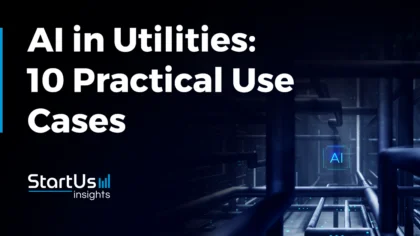
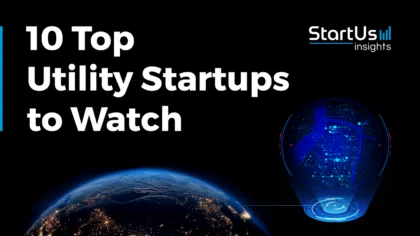
![Dive into the Top 10 Water Management Trends & Innovations [2026]](https://www.startus-insights.com/wp-content/uploads/2025/07/Water-Management-Trends-SharedImg-StartUs-Insights-noresize-1-420x236.webp)
